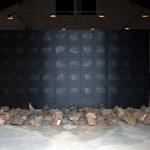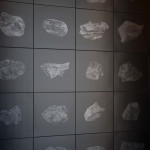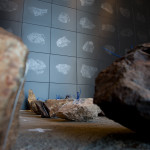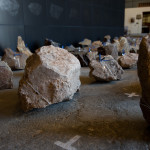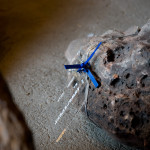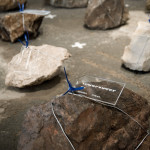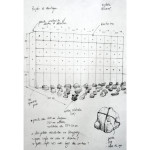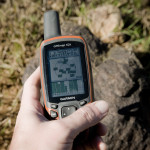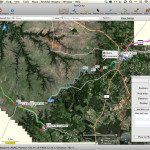Marcelo Moscheta | Displacing Territories
TITLE: Displacing Territories: Project for the Border Brazil/Uruguay
WORK: The act of collecting rocks from given places e take them to other places maybe one of the first civilization traces, at which time the man knows himself as converter of his own space and therefore, has the power to interfere in the Creation. As an unimportant object collector, I’ll develop an action of traveler who cross the Border Rio Grande do Sul/Uruguay in almost all its length and search for elements present in the local landscape to serve as representation of that territory. When I choose a rock, I mark its exact pick up localization and go through the border bringing it back to Brazil, its displacement accentuates de the idea of belonging – the where they were / the where are – and of a memory intrinsically deposited inside of such stones, their constituent mineral, their mass, their physical characteristics, their age on the millenniums that they’ve crossed. The work of the artist in this case, resembles the archeologist who collects, sorts and organizes the natural landscape. So, seeking to understand the Place: mine and the rock themselves, for I, when in Uruguayan side feel myself more Brazilian also. And thus, I bring Uruguay into Brazil, pieces that go through the border and reorganize themselves following parameters other than geology, geography, politic or economy. A country/place contained inside another represented in the future drawings that resemble photographs as if they were a memory catalog of the place, a memorabilia, a reclassification of the landscape in which the objects carry itself all information as possible of the place where they came from. I see the landscape as a counterpoint to measure yourself, an extern referential that can give the exact measure of myself. Romantic idea that pays reference to the last great explorations of the XIX century, where the poles of the planet and the summits of higher mountains were for sure, a discovery of the place and at the same a discovery of the limits of the men himself. My relation with the landscape rests in a first attempt to build an ideal place, an imitation of the nature as a faithful portrait of the relations of perfection and balance. By doing this, I want to cover all the ways of understanding a place, not only by sensitive medias as drawings or photographs, but through rational ways of understanding places: latitude, longitude, altitude, mathematical calculations and technical/scientific references. The mysteries of the force acting in secret in the nature are rebuilt, sometimes in a brutal manner, other, in a delicate and almost imperceptible way, in an act to fully understand the matter of what we are formed. DISPLACING TERRITORIES: PROJECT FOR THE BORDER BRAZIL/URUGUAY is a path as lonely traveler I accomplished at the end of April by the frontier zone of the pampas, specifically from Barra do Quaraí to Pelotas. My experience translates the rescue of the landscape memory, through the collection of stones classified and organized then. Its exhibition was held in the city of Pelotas, more specifically at the Art Museum Leopoldo Gotuzo, during the month of July and after at 8 Bienal do Mercosul, at Porto Alegre from september to december 2011.
Displacing Territories: Project for the Border Brazil/Uruguay
55 graphite drawings on PVC board, iron, and stain wire, magnetic sheet and plexiglass
300 x 600 x 300 cm
2011
* comissioned work for the 8 Bienal do Mercosul
TÍTULO: DESLOCANDO TERRITÓRIOS: PROJETO PARA A FRONTEIRA BRASIL/URUGUAY
TRABALHO: O ato de coletar pedras de determinado local e transportá-las a outro é talvez um dos primeiros traços de civilização, momento na qual o homem entende-se transformador de seu espaço e por conseguinte, possui o poder de interferir na Criação. Como um colecionador de objetos sem importância alguma, vou desenvolver uma ação de viajante que atravessa a Fronteira do Rio Grande do Sul/Uruguay em quase toda sua extensão e busca elementos presentes na paisagem local para servirem como própria representação daquele território. Quando escolho uma pedra, marco sua localização exata de coleta e atravesso a fronteira trazendo-a de volta ao Brasil, seu deslocamento acentua a idéia de pertencimento – o lugar onde estavam / o lugar onde estão – e de uma memória intrinsecamente depositada no interior de tais pedras, seu mineral constituinte, sua massa, suas características físicas, sua idade nos milênios que atravessou. O trabalho do artista nesse caso, assemelha-se ao do arqueólogo que recolhe, classifica e organiza a paisagem natural. Assim, procuro entender o Lugar: o meu e o das próprias rochas, pois eu, quando estou em lado uruguaio me sinto mais brasileiro também. E dessa forma, trago o Uruguay para dentro do Brasil, pedaços que atravessam as fronteiras e se reorganizam segundo parâmetros outros que não a geologia, a geografia, a polítca ou a economia. Um país/lugar contido dentro de outro, representado nos futuros desenhos que se assemelham a fotografias como se fossem um catálogo da memória do lugar, uma memorabilia, uma reclassificação da paisagem onde os objetos carregam em si toda a informação possível do lugar de onde vieram. Vejo a paisagem como um contraponto para medir a si mesmo, um referencial externo que possa dar a exata medida do tamanho do eu. Idéia romântica que presta reverência às últimas grandes explorações do século XIX, onde os pólos do planeta e os cumes dos montes mais altos eram por certo, uma descoberta do lugar ao mesmo tempo que uma descoberta do limite próprio do homem. Minha relação com a paisagem repousa numa tentativa primeira de construir um lugar ideal, uma imitação da natureza como retrato fiel das relações de perfeição e equilíbrio. Quero assim, abarcar todas as possibilidades de entender um local, não somente por meios sensíveis como o desenho ou a fotografia, mas através de formas racionais de se entender Lugar: latitude, longitude, altitude, cálculos matemáticos e referências técnico/científicas. Os mistérios da força que age em segredo na natureza são recriados, por vezes de maneira brutal, outras, de forma delicada e quase imperceptível, num ato de compreender de maneira integral a matéria da qual somos formados. DESLOCANDO TERRITÓRIOS: PROJETO PARA A FRONTEIRA BRASIL/URUGUAY é um trajeto como viajante solitário que realizei ao final do mês de abril pela zona fronteiriça dos pampas, especificamente desde a Barra do Quaraí até Pelotas. Minha experiência reflete o resgate da memória da paisagem, por meio do recolhimento de pedras classificadas e organizadas em seguida. Sua exposição foi realizada na cidade de Pelotas, mais especificamente no Museu de Arte Leopoldo Gotuzo, durante o mês de julho e depois como parte da 8 Bienal do Mercosul, realizada em Porto Alegre entre setembro e dezembro de 2011.
DESLOCANDO TERRITÓRIOS: PROJETO PARA A FRONTEIRA BRASIL/URUGUAY
55 desenhos à grafite sobre PVC expandido, ferro, cabos de aço, manta magnética e acrílico
300 x 600 x 300 cm
2011
* trabalho comissionado para a 8 Bienal do Mercosul
AUTOR
MARCELO MOSCHETA
São José do Rio Preto, 1976
Lives and works in Campinas
The common thread running through Moscheta’s work is a great fascination for nature, together with his willingness to travel and experience the landscape. This experience of traveling and living in difficult environments stimulated his interest in depicting the memory of a place in his works, developing a classification procedure like that of an archaeologist questioning the boundaries of territory, geography and physics through art. Since the beginning of his artistic career in 2000 he has created works and exhibitions arising out of journeys to remote places, where he collects objects from nature and reproduces them through drawing and photography, creating installations and objects. Recently, his interest is aimed to research borders and imposed limits to territories and also the relation betweens rivers and the landscape that follows their course. In 2015 the artist develops the Project Arrasto (Dragging) in which he drives through all the extension of the Tietê River and collects minerals at the river banks. Also, he researches ancestral memories at the River Trebbia, in Italy and at the Canadian/U.S. border. In 2014 Moscheta participates as resident artist in the Biennials of Vancouver and Montevideo, working on an expedition all over the Uruguay River. In his curriculum, attention to the solo shows Erosão Diferencial at MAC Campinas (2017), Seven Falls at Galeria Vermelho in 2016, 1.000 km, 10.000 years (2013) at Galeria Leme and the site-specific Contra.Céu (2010) at Morumbi’s Chapel. Commissioned by the 8 Biennial of Mercosul (2011), he has made his research along the extension of the Brazilian/Uruguayan border. Also in 2011, participated in artistic residency onbord a tall ship at Spitsbergen, North Pole. This experience resulted in the solo show NORTE (2012), made at Paço Imperial, RIo de Janeiro. In 2013 he participates in the collective show The Arctic, at the Louisiana Musem of Modern Art in Copenhagen. In 2010 he was awarded the I Pipa Prize Popular Vote, at MAM Rio. In 2009 was awarded in the Biennale de Gravure de Liège and made artistic residence at Vila Nova de Cerveira for the Biennial of Portugal, and participated also on the 4a. edition of Rumos ItaúCultural. In 2013, take part in the book Vitamin D2, Phaidon, an anthology of contemporary drawing. His works are in the collections Coleção Gilberto Chateaubriand/MAM-Rio, MAM Bahia, MAC Goiânia, MAM São Paulo, ItaúCultural, Pinacoteca do Estado de São Paulo. Internationally, his works are part of MAMAC Liège, Lhoist Collection – Bruxels, RNA Foundation Moscou, Deutsche Bank New York and Banco Espírito Santo. The artist is represented by Galeria Vermelho, SIM Galeria and Galleria Riccardo Crespi.
MARCELO MOSCHETA
São José do Rio Preto, 1976
Vive e trabalha em Campinas
Um fio condutor na obra de Moscheta é a grande fascinação que tem pela natureza, assim como a sua disposição aberta à viagem e o enfrentamento com os elementos retirados da paisagem. Essa experiência de viajar e conviver em ambientes agrestes despertou seu interesse em retratar a memória de um lugar, elaborando um procedimento de classificação similar ao arqueológico e que questiona, por meio da arte, as fronteiras do território, da geografia e da física. Desde o início da sua carreira artística, no ano 2000, o artista tem realizado obras e exposições que nascem de seus deslocamentos por lugares remotos, onde coleta objetos que provêm da natureza e que ele reproduz por meio do desenho e da fotografia, criando instalações e objetos. Recentemente tem voltado seu interesse para pesquisas com fronteiras e limites impostos a territórios e também na relação que os rios estabelecem com a paisagem ao longo de seu curso. Em 2015 desenvolve o projeto Arrasto em que percorre toda a extensão do Rio Tietê coletando minerais em suas duas margens e também pesquisa camadas ancestrais de memórias no Rio Trebbia, na Itália e na fronteira do Canadá e Estados Unidos. Em 2014 participa como residente nas Bienais de Vancouver e Montevideo, onde também realiza a expedição Oriente, ao longo do Rio Uruguay. Destacam-se em seu currículo as exposições individuais Erosão Diferencial (2017) no MAC Campinas, Sete Quedas (2016) sua primeira individual na Galeria Vermelho, 1.000 km, 10.000 anos (2013), na Galeria Leme e a instalação Contra.Céu (2010) realizada na Capela do Morumbi. Comissionado pela 8 Bienal do Mercosul (2011), realizou sua pesquisa em toda a extensão da fronteira entre Brasil e Uruguai. Também em 2011 participou de residência artística à bordo de um veleiro em Spitsbergen, no Pólo-Norte, resultando na exposição NORTE (2012), realizada no Paço Imperial. Em 2013, participa da publicação Vitamin D2, Editora Phaidon, uma antologia do desenho contemporâneo. O artista é representado pela Galeria Vermelho, SIM Galeria e Galleria Riccardo Crespi.
MOSCHETA, Marcelo. Marcelo Moscheta | Displacing Territories. ClimaCom – Cosmopolíticas da Imagem[online], Campinas , ano. 4, n. 10. Nov. 2017 . Available from: https://climacom.mudancasclimaticas.net.br/?p=7955
SEÇÃO ARTE |COSMOPOLÍTICAS DA IMAGEM |Ano 4, n. 10, 2017
ARQUIVO ARTE |TODAS EDIÇÕES ANTERIORES


